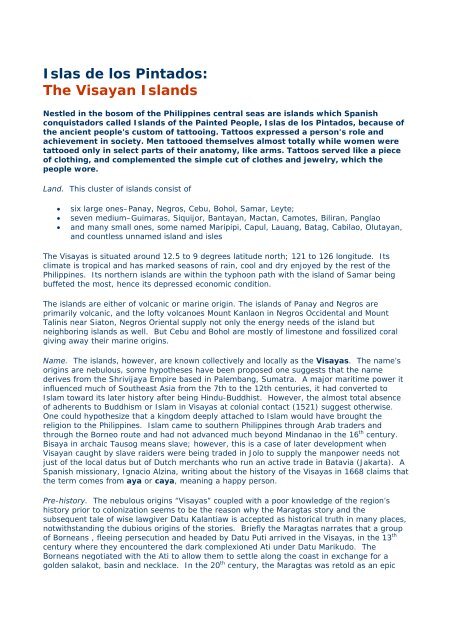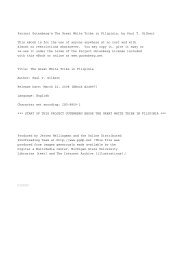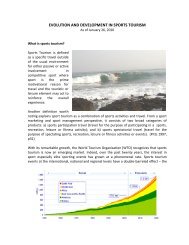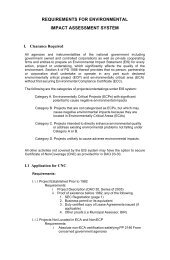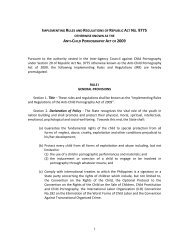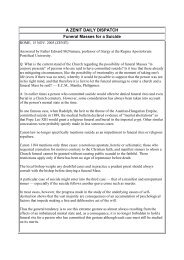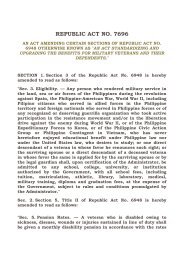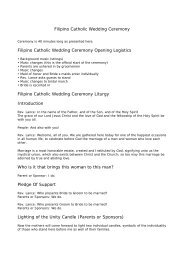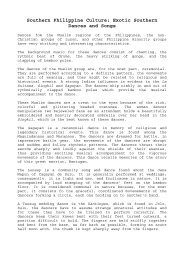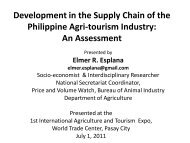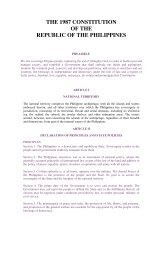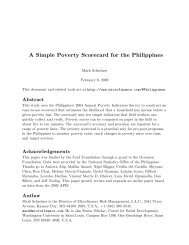Islas de los Pintados: - About the Philippines
Islas de los Pintados: - About the Philippines
Islas de los Pintados: - About the Philippines
You also want an ePaper? Increase the reach of your titles
YUMPU automatically turns print PDFs into web optimized ePapers that Google loves.
<strong>Islas</strong> <strong>de</strong> <strong>los</strong> <strong>Pintados</strong>:<br />
The Visayan Islands<br />
Nestled in <strong>the</strong> bosom of <strong>the</strong> <strong>Philippines</strong> central seas are islands which Spanish<br />
conquistadors called Islands of <strong>the</strong> Painted People, <strong>Islas</strong> <strong>de</strong> <strong>los</strong> <strong>Pintados</strong>, because of<br />
<strong>the</strong> ancient people's custom of tattooing. Tattoos expressed a person's role and<br />
achievement in society. Men tattooed <strong>the</strong>mselves almost totally while women were<br />
tattooed only in select parts of <strong>the</strong>ir anatomy, like arms. Tattoos served like a piece<br />
of clothing, and complemented <strong>the</strong> simple cut of clo<strong>the</strong>s and jewelry, which <strong>the</strong><br />
people wore.<br />
Land. This cluster of islands consist of<br />
• six large ones–Panay, Negros, Cebu, Bohol, Samar, Leyte;<br />
• seven medium–Guimaras, Siquijor, Bantayan, Mactan, Camotes, Biliran, Panglao<br />
• and many small ones, some named Maripipi, Capul, Lauang, Batag, Cabilao, Olutayan,<br />
and countless unnamed island and isles<br />
The Visayas is situated around 12.5 to 9 <strong>de</strong>grees latitu<strong>de</strong> north; 121 to 126 longitu<strong>de</strong>. Its<br />
climate is tropical and has marked seasons of rain, cool and dry enjoyed by <strong>the</strong> rest of <strong>the</strong><br />
<strong>Philippines</strong>. Its nor<strong>the</strong>rn islands are within <strong>the</strong> typhoon path with <strong>the</strong> island of Samar being<br />
buffeted <strong>the</strong> most, hence its <strong>de</strong>pressed economic condition.<br />
The islands are ei<strong>the</strong>r of volcanic or marine origin. The islands of Panay and Negros are<br />
primarily volcanic, and <strong>the</strong> lofty volcanoes Mount Kanlaon in Negros Occi<strong>de</strong>ntal and Mount<br />
Talinis near Siaton, Negros Oriental supply not only <strong>the</strong> energy needs of <strong>the</strong> island but<br />
neighboring islands as well. But Cebu and Bohol are mostly of limestone and fossilized coral<br />
giving away <strong>the</strong>ir marine origins.<br />
Name. The islands, however, are known collectively and locally as <strong>the</strong> Visayas. The name’s<br />
origins are nebulous, some hypo<strong>the</strong>ses have been proposed one suggests that <strong>the</strong> name<br />
<strong>de</strong>rives from <strong>the</strong> Shrivijaya Empire based in Palembang, Sumatra. A major maritime power it<br />
influenced much of Sou<strong>the</strong>ast Asia from <strong>the</strong> 7th to <strong>the</strong> 12th centuries, it had converted to<br />
Islam toward its later history after being Hindu-Buddhist. However, <strong>the</strong> almost total absence<br />
of adherents to Buddhism or Islam in Visayas at colonial contact (1521) suggest o<strong>the</strong>rwise.<br />
One could hypo<strong>the</strong>size that a kingdom <strong>de</strong>eply attached to Islam would have brought <strong>the</strong><br />
religion to <strong>the</strong> <strong>Philippines</strong>. Islam came to sou<strong>the</strong>rn <strong>Philippines</strong> through Arab tra<strong>de</strong>rs and<br />
through <strong>the</strong> Borneo route and had not advanced much beyond Mindanao in <strong>the</strong> 16 th century.<br />
Bisaya in archaic Tausog means slave; however, this is a case of later <strong>de</strong>velopment when<br />
Visayan caught by slave rai<strong>de</strong>rs were being tra<strong>de</strong>d in Jolo to supply <strong>the</strong> manpower needs not<br />
just of <strong>the</strong> local datus but of Dutch merchants who run an active tra<strong>de</strong> in Batavia (Jakarta). A<br />
Spanish missionary, Ignacio Alzina, writing about <strong>the</strong> history of <strong>the</strong> Visayas in 1668 claims that<br />
<strong>the</strong> term comes from aya or caya, meaning a happy person.<br />
Pre-history. The nebulous origins “Visayas” coupled with a poor knowledge of <strong>the</strong> region’s<br />
history prior to colonization seems to be <strong>the</strong> reason why <strong>the</strong> Maragtas story and <strong>the</strong><br />
subsequent tale of wise lawgiver Datu Kalantiaw is accepted as historical truth in many places,<br />
notwithstanding <strong>the</strong> dubious origins of <strong>the</strong> stories. Briefly <strong>the</strong> Maragtas narrates that a group<br />
of Borneans , fleeing persecution and hea<strong>de</strong>d by Datu Puti arrived in <strong>the</strong> Visayas, in <strong>the</strong> 13 th<br />
century where <strong>the</strong>y encountered <strong>the</strong> dark complexioned Ati un<strong>de</strong>r Datu Marikudo. The<br />
Borneans negotiated with <strong>the</strong> Ati to allow <strong>the</strong>m to settle along <strong>the</strong> coast in exchange for a<br />
gol<strong>de</strong>n salakot, basin and necklace. In <strong>the</strong> 20 th century, <strong>the</strong> Maragtas was retold as an epic
poem by <strong>the</strong> Ilongo poet, Ricaredo Demetillo, The Barter of Panay; staged as a multi-media<br />
drama, Dularawan, for <strong>the</strong> inauguration of <strong>the</strong> Cultural Center of <strong>the</strong> <strong>Philippines</strong>, and has<br />
become <strong>the</strong> subject of a dance suite by <strong>the</strong> famous Bayanihan Dancers. The rest of <strong>the</strong> tale is<br />
taken as historical truth (complete with dates) as shown in <strong>the</strong> following quotations from<br />
government publication (DOT Website) about:<br />
Iloilo<br />
Irong-Irong appears in <strong>the</strong> Maragtas legend of <strong>the</strong> coming of <strong>the</strong> ten Bornean datus to Panay<br />
who bartered gold for <strong>the</strong> plains and valleys of <strong>the</strong> island from a local Ati chieftain. One datu,<br />
Paiburong by name, was given <strong>the</strong> territory of Irong-Irong in what is now Iloilo. For 300 years<br />
before <strong>the</strong> coming of <strong>the</strong> Spaniards, <strong>the</strong> islan<strong>de</strong>rs lived in comparative prosperity and peace<br />
un<strong>de</strong>r an organized government and such laws as <strong>the</strong> Co<strong>de</strong> of Kalantiaw.<br />
Capiz<br />
And Aklan:<br />
Capiz is ano<strong>the</strong>r province whose name possesses a ra<strong>the</strong>r interesting etymology It was<br />
named based on <strong>the</strong> story that when <strong>the</strong> Spaniards came to Capiz in 1570, it was <strong>the</strong><br />
time when Datu Bankaya’s wife of <strong>the</strong> Aklan district gave birth to twin daughters. Twin<br />
is "Kapid" in <strong>the</strong> local dialect, so <strong>the</strong> Spaniards adopted <strong>the</strong> name Capiz (Kapid) as<br />
inadvertently miscommunicated to <strong>the</strong>m by <strong>the</strong> natives.<br />
Capiz, known as Aklan in pre-Spanish times, was one of <strong>the</strong> early settlements of <strong>the</strong><br />
Malayas, centuries before <strong>the</strong> coming of <strong>the</strong> Spaniards to <strong>the</strong> <strong>Philippines</strong>. It was part of<br />
<strong>the</strong> Confe<strong>de</strong>ration of Madjaas, formed after <strong>the</strong> purchase of Panay by <strong>the</strong> Bornean datus<br />
from <strong>the</strong> Negrito king named Marikudo.<br />
Aklan is <strong>the</strong> ol<strong>de</strong>st province in <strong>the</strong> <strong>Philippines</strong>, organized in 1213 by settlers from<br />
Borneo as <strong>the</strong> Minuro it Akean to inclu<strong>de</strong> what is now Capiz.<br />
The capital of Aklan changed location several times. Towards <strong>the</strong> end of <strong>the</strong> 14th century,<br />
Datu Dinagandan moved <strong>the</strong> capital to <strong>the</strong> present site of Batan which was captured in 1399<br />
by Chinese adventurers un<strong>de</strong>r Kalantiaw, who forthwith ruled Aklan. In 1433 <strong>the</strong> son of<br />
Kalantiaw, Kalantiaw III laid down a written co<strong>de</strong> of laws now known as <strong>the</strong> Co<strong>de</strong> of<br />
Kalantiaw. The short-lived Kalantiaw dynasty en<strong>de</strong>d when Kalantiaw III was slain in a duel<br />
with Datu Manduyog, legitimate successor to Datu Dinagandan. When Manduyog became <strong>the</strong><br />
new ruler, he moved <strong>the</strong> capital to Bakan (ancient name of Banga) in 1437. Several datus<br />
succee<strong>de</strong>d Manduyog when Miguel Lopez <strong>de</strong> Legaspi lan<strong>de</strong>d in Batan in 1565, Datu Kabayag<br />
was ruling Aklan from what is now <strong>the</strong> town of Libacac.<br />
Unfortunately as <strong>the</strong> historian William Henry Scott has pointed out <strong>the</strong> Maragtas goes no<br />
fur<strong>the</strong>r than 1907. “<strong>the</strong> Maragtas is an original work by Pedro A. Monteclaro published in<br />
mixed Hiligaynon and Kin-iraya in Iloilo in 1907 which claims to be nothing more than that. It<br />
is based on written and oral sources <strong>the</strong>n available, and contain three sorts of subject matter—<br />
folk customs still being practiced or remembered by old folks, <strong>the</strong> <strong>de</strong>scription of an i<strong>de</strong>alized<br />
confe<strong>de</strong>ration whose existence <strong>the</strong>re is reasonable grounds to doubt and for which <strong>the</strong>re is no<br />
evi<strong>de</strong>nce, and a legend recor<strong>de</strong>d in 1858 of a migration of Bornean settlers, some of whom are<br />
still remembered as folk heroes, pagan <strong>de</strong>ities, or progenitors of part of <strong>the</strong> present population<br />
of Panay. There is not reason to doubt that this legend preserves <strong>the</strong> memory of some actual<br />
event, but it is not possible to date <strong>the</strong> event itself or to <strong>de</strong>ci<strong>de</strong> which of its <strong>de</strong>tails are historic<br />
fact and which are <strong>the</strong> embellishments of generations of oral transmission (Scott 1984:103).
Regarding <strong>the</strong> Co<strong>de</strong> of Kalantiaw, Scott observes that its source is “<strong>the</strong> Marco-Pavón Antiguas<br />
Leyendas.” Jose E. Marco of Pontevedra, Negros Occi<strong>de</strong>ntal was a stamp collector and<br />
antiquarian who brought to <strong>the</strong> director to <strong>the</strong> American director of <strong>the</strong> National Library,<br />
Alexan<strong>de</strong>r Blair, supposedly ancient manuscripts about <strong>the</strong> Visayas. The Pavon manuscript<br />
was allegedly written by Fr. José María Pavon y Araguro, a priest of <strong>the</strong> Diocese of Cebu and<br />
assigned parish priest of Himamaylan (1843-49 [50?]). In 1848-49, <strong>the</strong> Recollects took<br />
charge of Negros and Pavon presumably returned to Cebu. O<strong>the</strong>r historians asi<strong>de</strong> from Scott<br />
doubt <strong>the</strong> au<strong>the</strong>nticity of manuscripts presented by Marco to <strong>the</strong> National Library. Regarding<br />
<strong>the</strong> Pavon manuscript, Scott conclu<strong>de</strong>s: “The Jose E. Marco contribution to Philippine<br />
historiography …appear to be <strong>de</strong>liberate fabrications with no historic validity. There is<br />
<strong>the</strong>refore no present evi<strong>de</strong>nce that any Filipino ruler by <strong>the</strong> name of Kalantiaw ever existed or<br />
that <strong>the</strong> Kalantiaw penal co<strong>de</strong> is any ol<strong>de</strong>r than 1914” (Scott 1984: 134).<br />
The postwar impetus to provi<strong>de</strong> <strong>the</strong> Visayas a facile prehistory does not <strong>de</strong>ny that <strong>the</strong> Visayas<br />
had a rich history. Although <strong>the</strong> archaeological of <strong>the</strong> islands is very much incomplete,<br />
tantalizing evi<strong>de</strong>nce of rich culture have been found. In <strong>the</strong> island of Banton, Romblon<br />
(politically part of Region 4, Sou<strong>the</strong>rn Tagalog, though culturally Visayan) a warp ikat cloth<br />
was found in a burial site. Dated to <strong>the</strong> 12 th century it is probably <strong>the</strong> ol<strong>de</strong>st example of ikat<br />
weave from Sou<strong>the</strong>ast Asia. The Museo <strong>de</strong> Iloilo display not just Neolithic pottery and<br />
implements but a gold <strong>de</strong>ath mask unear<strong>the</strong>d in Oton. Samar is yielding many gold ornaments<br />
from areas controlled by <strong>the</strong> NPA. These prehispanic jewelry finds its way to <strong>the</strong> antique<br />
market, though badly documented regarding provenance, and almost useless archaeologically.<br />
Cebu’s University of San Car<strong>los</strong> displays artifacts unear<strong>the</strong>d within Cebu City during an<br />
archaeological excavation conducted by <strong>the</strong> University. Bohol’s Baclayon church stores some<br />
haligi or house posts (claimed to be pre-colonial) recovered from <strong>the</strong> Dauis Strait.<br />
All <strong>the</strong>se evi<strong>de</strong>nces point to a rich history needing reconstruction. Extensive excavations along<br />
<strong>the</strong> Tanay River have uncovered prehistoric evi<strong>de</strong>nce of settlements, of associated artifacts,<br />
including Chinese tra<strong>de</strong> ware, suggesting a lively commerce along this waterway.<br />
Languages and dialects. The Visayans speak a variety of related languages, not just dialects,<br />
although dialect varieties exist.<br />
The principal languages are<br />
• Hiligaynon, with variations especially marked among <strong>the</strong> Ilongo, Antiqueño and<br />
Capiznon, spoken in <strong>the</strong> provinces of Iloilo, Capiz, Antique and Negros Occi<strong>de</strong>ntal<br />
• Sugbuhanon , Bisaya, Binisaya or Cebuano Visayan is spoken in Cebu, Negros Oriental,<br />
Siquijor, Western Leyte, Bantayan and Camotes; and a dialect, characterized by <strong>the</strong><br />
hard pronunciation of “y”, Boholano or Bol-anon in Bohol, although constant<br />
interchange between Cebu is slowly eroding <strong>the</strong> distinctions;<br />
• Popularly called Waray (because <strong>the</strong> prevalence of <strong>the</strong> rolling “R” sound) but Samar-<br />
Leyte Visayan by linguistic scholars is <strong>the</strong> language distinct to Samar and Eastern<br />
Leyte.<br />
O<strong>the</strong>r minor languages exist<br />
• Akaenon or Aklanon spoken in Aklan,<br />
• Kinaray-a or Kin-iraya, an ol<strong>de</strong>r variety of Hiligaynon, is spoken in <strong>the</strong> interior towns of<br />
Panay Island.<br />
• Abacnon, Capulon, a cognate of Tausog, spoken by about 1500 persons in Capul Island,<br />
off nor<strong>the</strong>rn Samar
• Although Romblon and Cagayancillo now belong to Region IV, Sou<strong>the</strong>rn Tagalog and<br />
Masbate to Region V, Bicol, inhabitants of <strong>the</strong>se islands speak a language akin to<br />
Hiligaynon<br />
o Rombloanon in Romblon<br />
o Bantoanon in Banton<br />
o<br />
o<br />
Masbateño in Masbate<br />
Cagayancillo’s lingua franca is Hiligaynon as most of <strong>the</strong> inhabitants are from<br />
Iloilo or Antique. These settlers continue maintaining economic ties with Panay<br />
for it is far more convenient to sail to Anini-y on Panay’s southwestern tip than<br />
to go to Puerto Princesa un<strong>de</strong>r whose political jurisdiction Cagayancillo falls.<br />
• and a variety of languages tribal languages spoken by minorities: <strong>the</strong> Sulod of Panay,<br />
Bukidnon, Mahagat and Karolon of Negros, and Ati or Ayta.<br />
Administration. For purposes of administration <strong>the</strong> islands are divi<strong>de</strong>d into Western, Central<br />
and Eastern Visayas. Western Visayas is ma<strong>de</strong> up of <strong>the</strong> principal islands of Panay and<br />
Guimaras, <strong>the</strong> province of Negros Occi<strong>de</strong>ntal and nearby islands and islets. Central Visayas is<br />
ma<strong>de</strong> up of <strong>the</strong> islands of Cebu, Bantayan, Camotes, Bohol, Panglao, Negros Oriental, Siquijor<br />
and nearby islands and islets; and Eastern Visayas, Samar, Leyte, Biliran, Lauang, and<br />
neighboring islands.<br />
Travel: The Visayan islands, though related culturally, are distinct from each o<strong>the</strong>r, so that<br />
island hopping becomes a pleasant experience of variety. And most islands are physically not<br />
too far from each o<strong>the</strong>r, on <strong>the</strong> average 20 to 30 nautical miles distant. The distance is even<br />
ma<strong>de</strong> shorter by <strong>the</strong> ready availability of fast, hi-tech catamaran type ferries that sail from <strong>the</strong><br />
principal harbors for adjacent islands, approximately every hour. It is possible to plan trips so<br />
that you can tour an island one day, and be on <strong>the</strong> next island <strong>the</strong> following.<br />
It is also possible to travel by public transportation from one island to <strong>the</strong> next. A bus line<br />
connects Bacolod City, Negros Occi<strong>de</strong>ntal with Cebu. The bus is loa<strong>de</strong>d on a roro (roll in, roll<br />
out) ferry for <strong>the</strong> sea crossing. Within <strong>the</strong> islands asi<strong>de</strong> from buses, FX vans are available.<br />
These are probably more convenient because of <strong>the</strong>ir frequent trips and few stops along <strong>the</strong><br />
way, although sitting is tight because <strong>the</strong> vans are small and crow<strong>de</strong>d.<br />
Our island-hopping heritage tour of <strong>the</strong> Visayas takes advantage of this convenience. It begins<br />
with Cebu as a hub, moves south to Bohol, <strong>the</strong>n north to Dumaguete, Bacolod, Iloilo, ending in<br />
Capiz for <strong>the</strong> culture buffs or <strong>the</strong> very popular white-sand beach of Boracay.<br />
To get from Manila <strong>the</strong> Cebu <strong>the</strong> most convenient way is to travel by air, however, sea travel is<br />
also available. The government has recently rationalized <strong>the</strong> roro services between islands. It<br />
is now possible to travel to Boracay, Aklan from Cubao, Quezon City, Metro Manila. The trip<br />
takes 15 hours. From <strong>the</strong>n onwards public buses are available. But be warned, <strong>the</strong> buses may<br />
lack in comfort. So <strong>the</strong> bus and roro option are for <strong>the</strong> adventurous.


